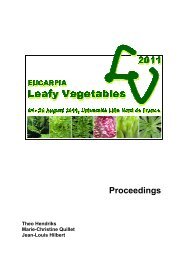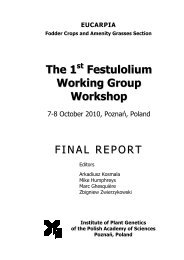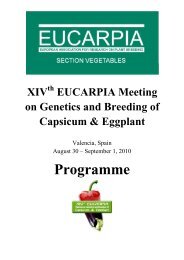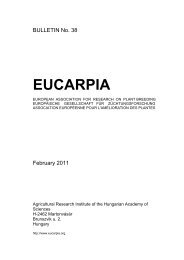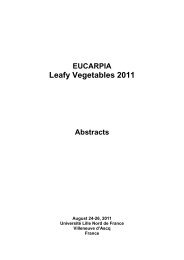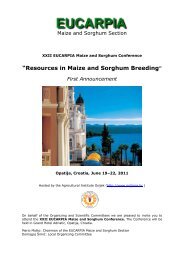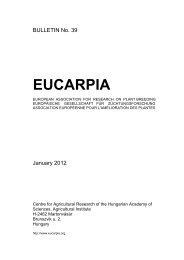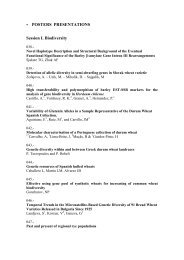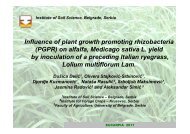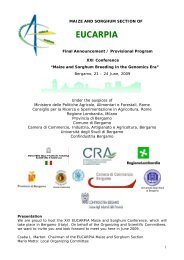Plant breeding for organic and sustainable, low-input agriculture
Plant breeding for organic and sustainable, low-input agriculture
Plant breeding for organic and sustainable, low-input agriculture
Create successful ePaper yourself
Turn your PDF publications into a flip-book with our unique Google optimized e-Paper software.
Evaluation of 36 lentil (Lens culinaris Medik.) genotypes under conventional <strong>and</strong> <strong>organic</strong><br />
environment<br />
Dimitrios Vlachostergios 1 , Dimitrios Baxevanos 2 , Demetrios Roupakias 3 .<br />
1 Fodder Crops <strong>and</strong> Pasture Institute, Larissa Greece.<br />
2 Lab. of Biometry, Sch. of Agricultural Sciences, University of Thessaly, Volos Greece<br />
3 Lab. of Genetics <strong>and</strong> <strong>Plant</strong> Breeding, Aristotle University of Thessaloniki, Greece<br />
Lentil (Lens culinaris Medik.) is an important crop throughout the Meditterrenean region, W.<br />
Asia, <strong>and</strong> N. America (Erskine W., 1996). It is also broadely used in <strong>organic</strong> <strong>agriculture</strong> as it<br />
improves soil fertility. The main objectives in the current study were: (1) to investigate the<br />
productivity of lentil genotypes under <strong>organic</strong> <strong>and</strong> conventional management <strong>and</strong> (2) to detect<br />
the promising genetic material <strong>for</strong> an <strong>organic</strong> plant <strong>breeding</strong> program.<br />
Thirty six lentil varieties were evaluated under <strong>organic</strong> <strong>and</strong> conventional environments under<br />
field experiments that were established <strong>for</strong> two consecutive years at the Fodder Crops <strong>and</strong><br />
Pastures Institute in Larissa, Greece. The genetic material studied originated from Greece,<br />
ICARDA, Morocco, India, Turkey, Jordan, Chile, Canada, USA, Algeria <strong>and</strong> Bulgaria. In the<br />
conventional trial plots st<strong>and</strong>ard cultural practices (P mineral fertilization & pest control) were<br />
applied throughout the growing season, while in the <strong>organic</strong> ones no fertilizers or pest<br />
agrochemicals were applied. The experimental field arrangement was the triple lattice with three<br />
replications. ANOVA <strong>and</strong> GGE Biplot analysis were applied <strong>for</strong> identifying significant<br />
differences <strong>and</strong> repeatable GEI patterns in relation to genotype adaptability <strong>and</strong> stability.<br />
ANOVA indicated statistically significant differences between genotypes <strong>and</strong> environments.<br />
GxE interaction (GEI) was also significant. It was observed that under conventional management<br />
most genotypes had a higher yield compared to the <strong>organic</strong> one. This is likely due to the effect of<br />
fertilizers <strong>and</strong> pest control applied under conventional management. On the other h<strong>and</strong>, certain<br />
genotypes adapted better under <strong>organic</strong> environment. The ranking of the mean yield per<br />
genotype <strong>and</strong> environment revealed two types of GEI. Firstly, genotypes occupying the same<br />
ranking position at both the <strong>organic</strong> <strong>and</strong> the conventional environment (non-crossover GEI), <strong>and</strong><br />
secondly, those that exhibited a significant alter in the ranking (crossover GEI) under the two<br />
environments. Thus, among the 10% highest yielding genotypes under the conventional<br />
environment there was also included half of the 10% highest yielding genotypes under the<br />
<strong>organic</strong> environment. Moreover, these genotypes exhibited broad adaptability <strong>and</strong> stability. This<br />
observation is in agreement with the statement: a lot of genetic material developed under<br />
conventional management is also exploitable in <strong>organic</strong> <strong>agriculture</strong> (Vogt - Kaute W., 2001).<br />
Finally, most of the <strong>low</strong> yielding genetic material was at the bottom of the rank under both the<br />
conventional <strong>and</strong> <strong>organic</strong> environment.<br />
43




